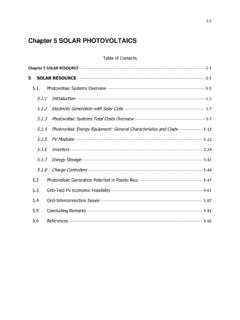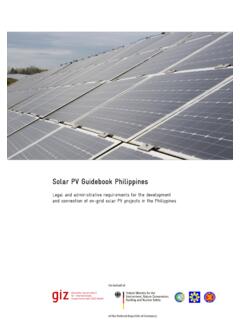Transcription of Fact Sheet: Making the Case for Solar Grazing
1 | | Sheet: Making the Case for Solar GrazingAs Solar projects across the nation continue to expand, Solar Grazing has emerged as a valuable tool. Using livestock to manage vegetation at Solar sites can enhance site value by keeping land in agricultural use, providing new income streams for local farmers, and adding environmental benefits such as decreased erosion and enhanced soil health. Agrivoltaics is a term used to describe combining agriculture with renewable energy . Other types of agrivoltaics include producing hay, berries, vegetables, and honey at Solar Grazing is the utilization of livestock, usually sheep, to manage vegetation at Solar sites. It takes the place of traditional mowing, offering numerous environmental and financial benefits and meeting clean energy and agricultural goals simultaneously. For project developers, contracting with local farmers to use Solar Grazing as a management tool can reduce operations and maintenance costs.
2 A 2018 Cornell University study found that managing Solar site vegetation with sheep Grazing required two and half times less labor, Making it less expensive than traditional Meanwhile, Solar Grazing provides livestock owners with additional pasture opportunities and the chance to be paid for a valuable service, increasing income to their business and adding to the economy of the rural communities where these projects are usually benefitsSolar Grazing can also add environmental benefits to a project site. Introducing livestock onto the landscape and partnering them with native vegetation can improve soil health and reduce runoff. The deep, complex root systems of native vegetation help retain water, reduce topsoil loss, and provide wildlife and pollinator Sites with native vegetation can have three and one-half times more pollinators than sites This vegetation provides habitat for bees and other pollinators, as well as ground nesting birds including sage grouse, pheasants, and quail.
3 Pollinator plantings can coexist with Solar Grazing with careful planning and management, such as developing a rotational Grazing plan that accommodates vegetation bloom Frenay, Erica. Solar Grazing : Livestock as Landscapers at Utility-Scale Solar Arrays. Cornell Small Farm Program, July 20, 2020, smallfarms. scale- Solar -arrays. Accessed November Kochendoerfer, Nikola, et al. The agricultural, economic and environ-mental potential of co-locating utility scale Solar with Grazing sheep. David R. Atkinson Center for a Sustainable Future, Cornell University, 2019, Accessed November Dreves, Harrison. Beneath Solar Panels, the Seeds of Opportunity Sprout: Low-Impact Development of Solar Installations Could be Win-Win-Win for Food, Water, and Renewable energy . National Renewable energy Laboratory, 2019, Accessed November Schulte, Lisa A.
4 , et al. Prairie strips improve biodiversity and the delivery of multiple ecosystem services from corn-soybean croplands. Proceedings of the National Academy of Sciences of the United States of America, Oct. 17, 2017, Accessed November Solar Grazing FAQ. American Solar Grazing Association, Accessed November | | settingDevelopers should identify their project goals and build a site plan that reflects the Solar Grazing co-usage goals. Other beneficial practices, such as pollinator or wildlife habitat and establishment of native vegetation, should be considered, but weighing how these goals can complement or impede each other is site conditionsDevelopers should develop a timeline for site establishment. Introduction of regular livestock Grazing should be withheld until native vegetation at the site is fully established between one and three years.
5 Flash Grazing during this period can be used for weed control. Consulting with local experts is key when selecting a seed mix for the site that is regionally appropriate and suitable for livestock Grazing . Other factors that should be considered include site size, accessibility of the site, electricity and water access, and fencing. Although wildlife fencing provides benefits to sites with native plantings, it is not suited for Grazing sites due to the gaps at the livestock species and determine populationSheep are the most widely used and best-suited livestock for Solar They are smaller than cattle and are not likely to damage equipment. Cattle have been successfully used in Solar sites, but panel height becomes a necessary Determining the number of animals used during Grazing management will depend on available forage and the length of the Grazing a robust rotational Grazing and vegetation management plan for the site Creating a rotational Grazing plan is key to ensuring proper management of vegetation and for the health of Grazing animals.
6 Consult with local Grazing experts to create a goal-oriented, site-specific plan. Temporary fencing may be employed for mob or rotational Grazing . Sheep should be moved at least once a week to allow recovery of grazed plants and should not return to a previously grazed paddock for at least six , continued6 Personal communication, Audrey Lomax, Grazing Manager, Minnesota Native Landscapes, October What is Solar Grazing ? American Solar Grazing Association, Accessed November Sharpe, , et al. Evaluation of Solar photovoltaic systems to shade cows in a pasture-based dairy herd. Journal of Dairy Science, March 2021, Accessed November Frenay, Erica. Solar Grazing : Livestock as Landscapers at Utility-Scale Solar Arrays. Cornell Small Farm Program, July 20, 2020, smallfarms. scale- Solar -arrays. Accessed November 4 STEP 1 STEP 2 STEP 3 PlanningIncluding Solar Grazing as a goal in the beginning stages of project planning will allow developers to tailor sites for optimal Grazing management.
7 Solar Grazing is most successful when deployed as part of a strategic, rotational Grazing courtesy of Minnesota Native | | and farmers must work together to develop contracts that serve the needs of both parties. Longer-term contracts allow farmers to make investments in best practices. Site managers should ensure fencing, gates, and water access are Carrying proper insurance and having clear contracts that spell out who is allowed at the site is important for the safety of the animals, equipment, and Grazing and seed mixesSeed mixes should be regionally appropriate and site-specific. Consult with local experts to develop a location-specific mix. Many seed mixes can support both pollinators and livestock. If pollinator habitat is a goal, carefully timing Grazing schedules is necessary to accommodate bloom can develop zoning and tax policies that incentivize beneficial practices, such as Solar Grazing .
8 It is important to recognize that vegetation management goals may differ from site to site. Ordinances that include native vegetation and/ or pollinator-friendly rules should not be so strict that they reduce opportunities for other beneficial practices, such as Grazing . In 2021, New Jersey enacted a Dual-Use Solar Law which provides an incentive for keeping land at Solar sites in agricultural production. S3484 established a pilot program allowing unpreserved farmland used for dual-use Solar projects to be eligible for farmland assessment under certain Under the Massachusetts Department of energy s Solar Massachusetts Renewable Target (SMART) program, specific kinds of dual-use Solar systems, known as Agricultural Solar Tariff Generation Units, can qualify for financial incentives. To qualify, the land under the Solar system must be in continuous agricultural , continued10 Recommendations.
9 American Solar Grazing Association, Accessed November Chapter 170. New Jersey Legislature, 2021, Accessed November Dual-Use: Agriculture and Solar Photovoltaics. University of Massa-chusetts Amherst, Center for Agriculture, Food, and the Environment, May 2018, Solar -photovoltaics. Accessed November 2021.










